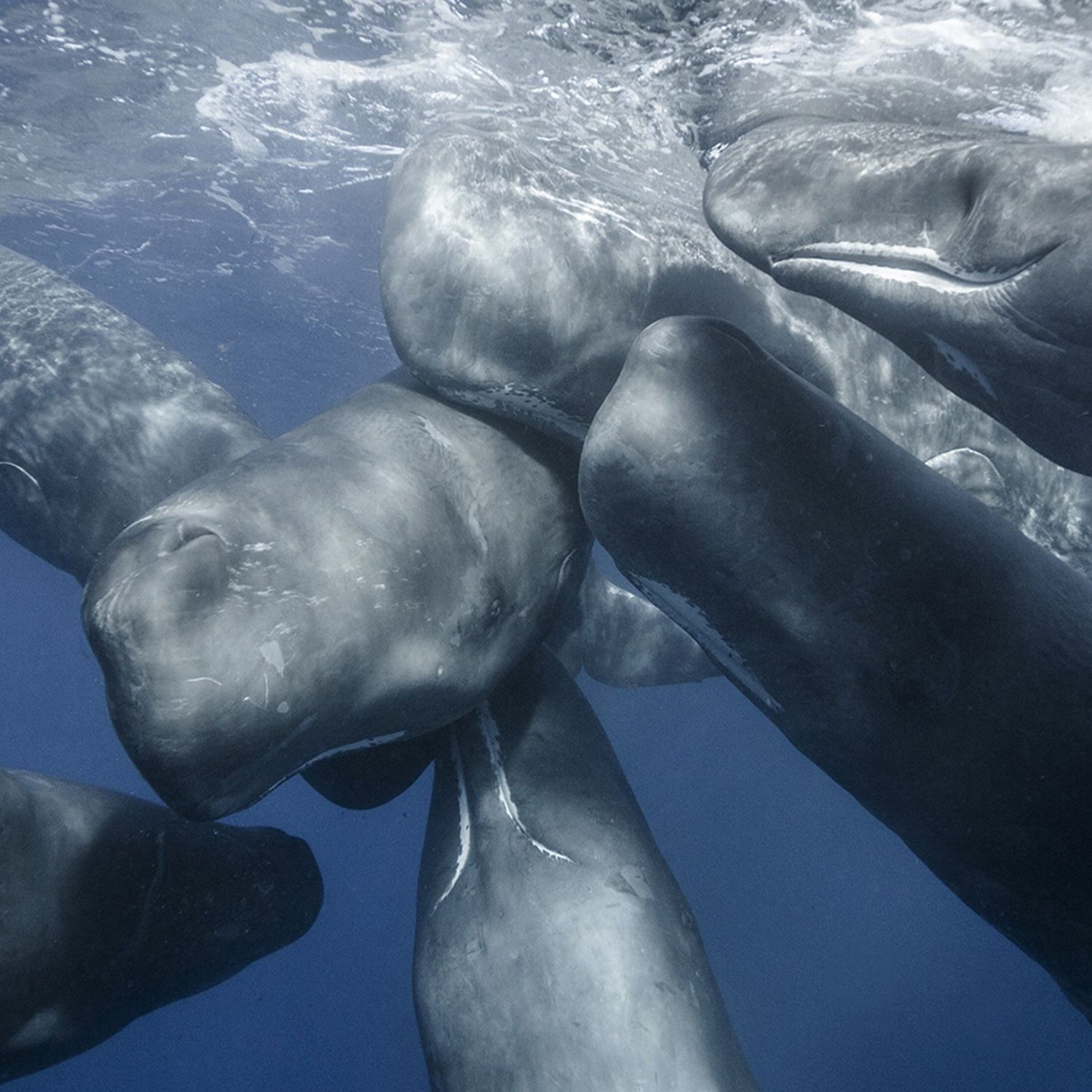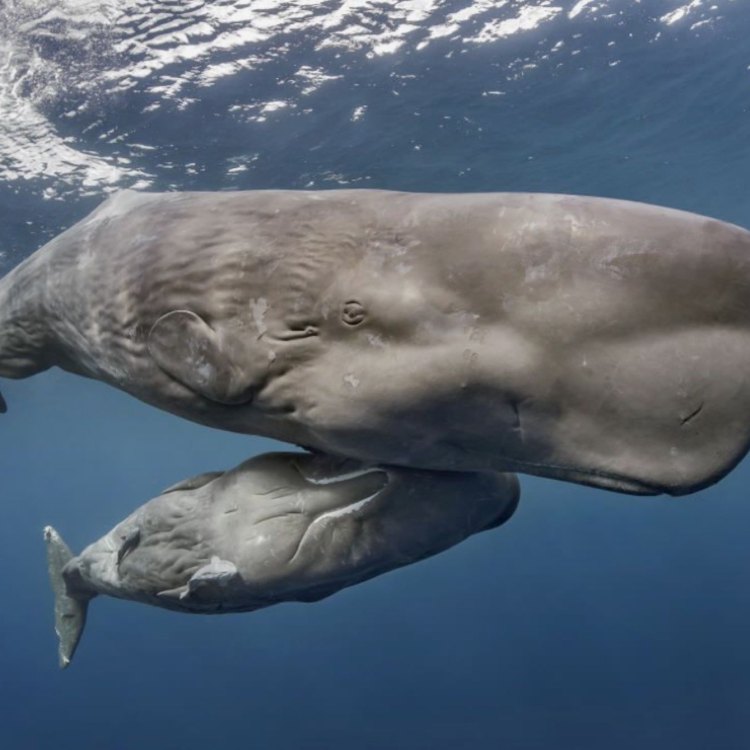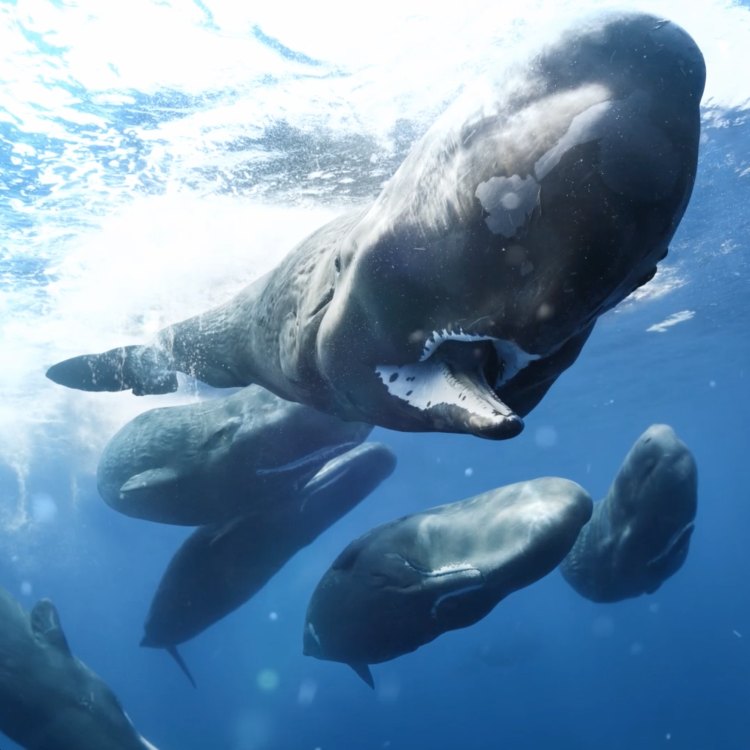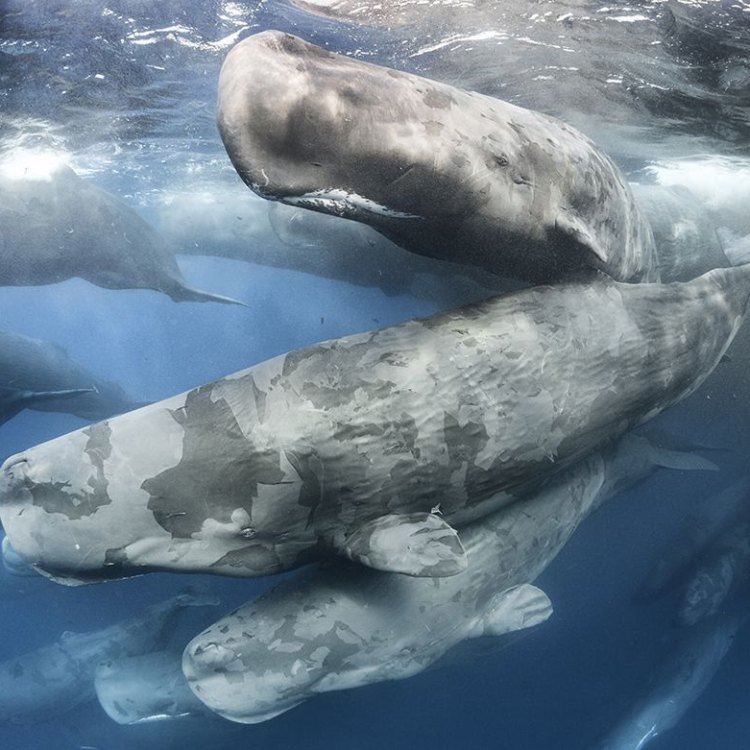
Sperm Whale
Up to 60 ft (18 m)
Sperm whales, also known as the giants of the sea, can grow up to 60 feet and weigh over 45 tons. These magnificent creatures can be found in oceanic waters all around the world. With their large and robust bodies and a distinct forehead, they are an impressive sight to behold. Belonging to the Physeteridae family, sperm whales are known for their distinctive clicks and echolocation capabilities, making them valuable in marine research.
Animal Details Summary:
Common Name: Sperm Whale
Kingdom: Animalia
Habitat: Open ocean, deep waters
The Mighty Sperm Whale: A Master of the Ocean
When we think about whales, we often picture the majestic blue whale or the playful humpback whale. However, there is one type of whale that stands out, not only for its massive size but also for its unique features and abilities - the sperm whale.Scientifically known as Physeter macrocephalus, the sperm whale is the largest of the toothed whales and is considered the apex predator of the open ocean. It has been revered and feared by humans for centuries, playing a significant role in literature, art, and even as a source of oil and ambergris in the past Sperm Whale. In this article, we will explore the fascinating world of the sperm whale, from its physical appearance to its incredible hunting techniques.
The Physical Characteristics of the Sperm Whale
The sperm whale belongs to the Animalia kingdom and the Chordata phylum, making it a mammal just like us. It is part of the Cetacea order, which includes all whales, dolphins, and porpoises. And within the order of Cetacea, the sperm whale is part of the Physeteridae family, along with its cousin, the pygmy sperm whale.One of the first things that catch our attention about the sperm whale is its sheer size. It reaches an impressive length of up to 60 feet (18 meters) and up to 100,000 pounds in weight, making it the largest toothed animal on Earth. Its large and robust body is covered in mostly dark gray or brown skin, with a small white patch on the belly.
But the most distinctive feature of the sperm whale is its large, square-shaped head, which makes up a third of its body length. This is the reason it was also called the "cachalot" in the past, derived from the French word "cachalote," meaning "big head Sugar Glider."
The Habitat and Feeding Habits of the Sperm Whale
Sperm whales are found in open ocean waters all over the world, ranging from polar regions to equatorial waters. They prefer living in deep waters, often diving to depths of up to 3,000 feet (914 meters), where they hunt for their prey.As carnivores, the sperm whale's diet consists mainly of giant and colossal squids, but they are also known to feed on fish, octopus, and even smaller whale species. They have a unique method of hunting, using a technique called "lunge feeding." This involves propelling themselves towards their prey with their powerful tail and then quickly swallowing the prey whole, using their enormous mouths and large throat and stomach capacity.
The Amazing Communication Abilities of the Sperm Whale
Another fascinating aspect of the sperm whale is its incredible communication abilities. Like other whales, they use echolocation to navigate and communicate with each other. However, sperm whales have a unique way of producing clicks - they have a special organ in their head called the "spermaceti organ" that contains a waxy, oily substance known as "spermaceti."When sperm whales produce clicks, the sound waves pass through this organ, and its position can be altered to change the sound's frequency. This allows them to create different types of clicks for various purposes, such as echolocation, communication, and even stunning their prey.
Researchers have observed that sperm whales have a complex system of communication, with specific clicks used for different purposes and even different dialects within different groups of sperm whales. This makes them one of the most advanced animals in terms of communication.
The Conservation Status of the Sperm Whale
The sperm whale has a global distribution, inhabiting all the world's oceans, and is not considered endangered as a species. However, due to historical whaling practices, their population has been significantly reduced. Japan, Norway, and Iceland are the only countries that still actively hunt sperm whales, but the international whaling moratorium has significantly reduced the number of sperm whales killed annually.Aside from whaling, sperm whales also face threats from pollution, entanglement in fishing gear, and the effects of climate change on their prey. Conservation efforts are ongoing to monitor and protect the sperm whale population, including tracking their migration patterns and studying their behaviors to better understand their needs and the threats they face.
The Sperm Whale in Culture and Literature
The sperm whale has played a significant role in human culture for centuries, appearing in ancient art, literature, and mythology. It has been referenced in various ancient cultures, such as Greek, Roman, and Norse mythology, often symbolizing strength, power, and intelligence.In literature, the sperm whale was famously portrayed as the antagonist in Herman Melville's classic novel, "Moby-Dick," regarded as one of the greatest works of American literature. The novel tells the story of Captain Ahab's obsession to hunt down and kill a giant sperm whale named Moby-Dick, representing the human struggle against nature and fate.
In Conclusion
The sperm whale is a truly fascinating creature, with its massive size, unique physical features, incredible hunting techniques, and advanced communication abilities. Despite the threats they face, sperm whales continue to roam the vast oceans, reminding us of the diversity and wonder of the natural world.As we continue to explore and learn about these magnificent creatures, it is essential to prioritize their conservation and protect them for future generations to appreciate and admire. And the next time we hear the famous line, "Call me Ishmael," let us remember the extraordinary sperm whale that captured the imaginations of millions.

Sperm Whale
Animal Details Sperm Whale - Scientific Name: Physeter macrocephalus
- Category: Animals S
- Scientific Name: Physeter macrocephalus
- Common Name: Sperm Whale
- Kingdom: Animalia
- Phylum: Chordata
- Class: Mammalia
- Order: Cetacea
- Family: Physeteridae
- Habitat: Open ocean, deep waters
- Feeding Method: Carnivorous
- Geographical Distribution: Global
- Country of Origin: N/A
- Location: Oceanic waters
- Animal Coloration: Mostly dark gray or brown
- Body Shape: Large and robust, with a distinct forehead
- Length: Up to 60 ft (18 m)

Sperm Whale
- Adult Size: Large
- Average Lifespan: About 70 years
- Reproduction: Sexual
- Reproductive Behavior: Mating occurs during the winter and spring
- Sound or Call: Produce a variety of clicks and vocalizations
- Migration Pattern: Some populations undertake long-distance migrations
- Social Groups: Live in social groups called pods
- Behavior: Known for their deep dives and ability to hunt in deep waters
- Threats: Whaling, marine pollution, climate change
- Conservation Status: Vulnerable
- Impact on Ecosystem: Role as an apex predator and carbon sink
- Human Use: Historically hunted for their blubber and oil
- Distinctive Features: Enormous head and large, square-shaped head
- Interesting Facts: Have the largest brain of any animal, can dive to great depths
- Predator: No natural predators

Physeter macrocephalus
The Magnificent Sperm Whale: A Marvelous Giant of the Ocean
The ocean is a vast and mysterious place, full of creatures both beautiful and terrifying. And one of the most fascinating and majestic creatures that call the ocean home is the sperm whale. With its enormous head and deep-diving abilities, the sperm whale has captured the imagination of humans for centuries. In this article, we'll delve into the unique features of this incredible animal, its role in the ecosystem, and the threats it faces PeaceOfAnimals.Com.The sperm whale, otherwise known as Physeter macrocephalus, is the largest of the toothed whales and one of the largest predators on the planet. Adult males can grow up to a whopping 59 feet in length, while females are slightly smaller, reaching up to 36 feet. They can weigh as much as 45-70 tons, making them one of the largest animals on Earth.
These majestic creatures have an incredible lifespan, with an average of about 70 years. Some individuals have been known to live up to 100 years in the wild, making them one of the longest-living mammals on the planet. This longevity is even more impressive when you consider the harsh and constantly changing environment they inhabit.
Reproduction in sperm whales is sexual, with mating occurring during the winter and spring months. Males compete for females through aggressive and vocal displays, with the victorious male mating with several females in a pod. Once impregnated, the female carries the calf for about 14-16 months before giving birth Swedish Elkhound. A newborn sperm whale can weigh up to 2 tons and nursing lasts for about two years.
These deep divers are well-known for their impressive vocalizations and clicks. In fact, they produce one of the loudest sounds in the animal kingdom, with their click-like vocalizations reaching up to 230 decibels. These vocalizations are used for communication, navigating, hunting, and possibly even for mating purposes.
But their impressive vocal abilities are not just about volume. Sperm whales produce a variety of clicks and vocalizations, each with a unique sound and purpose. These sounds are highly complex and vary depending on the situation and the individual whale producing them. Scientists are still working to decipher the meaning and complexity of the sperm whale's vocalizations.
Another interesting behavior of sperm whales is their migration patterns. While some populations are resident, staying in a particular location year-round, others undertake long-distance migrations. These migrations can span hundreds or even thousands of miles, and scientists are still trying to understand the reasons behind these journeys.
Sperm whales are highly social creatures and live in groups called pods. These pods can consist of up to 20 individuals and are led by a dominant female, known as the matriarch. The members of the pod work together to hunt, communicate, and care for the young.
One of the most distinctive features of the sperm whale is its gigantic head, which can be as large as one-third of its body length. This is the largest head-to-body ratio of any animal, and it is filled with a substance called spermaceti. This oil-like substance plays a crucial role in helping the sperm whale regulate its buoyancy for deep dives.
And speaking of deep dives, sperm whales are known for their incredible diving abilities. They can hold their breath for up to 90 minutes and dive to depths of up to 7,000 feet. These deep dives allow them to hunt for their preferred prey, giant squid, which can be found at depths of up to 3,000 feet.
But these magnificent creatures face several threats in the wild, primarily from human activities. The most significant threat is whaling, which has been a long-standing practice for centuries. Sperm whales were historically hunted for their blubber and oil, used for products such as candles, soap, and machine lubricants. This led to a significant decline in population and nearly drove them to extinction. While commercial whaling has ceased, they are still hunted for their meat in some parts of the world.
Marine pollution is another major threat to the sperm whale population. These whales are often found with plastic debris in their stomachs, causing serious harm to their health. Additionally, as apex predators, they can accumulate high levels of toxins from the prey they eat. Chemical pollution can cause serious health issues and reproductive problems for these giants of the sea.
Climate change is also impacting sperm whales and their habitats. As ocean temperatures rise, it affects the availability of their prey. This can lead to malnutrition, starvation, and even reproduction issues, further threatening their population.
The International Union for Conservation of Nature (IUCN) lists the sperm whale as a Vulnerable species, with their population declining by about 50% over the past three generations. However, there are efforts to protect and conserve these magnificent creatures. The implementation of strict conservation laws and regulations has helped to reduce the hunting of sperm whales. Additionally, organizations and individuals work towards reducing marine pollution and addressing the impact of climate change on the ocean.
The sperm whale's role in the ecosystem cannot be overlooked. As apex predators, they play a crucial role in maintaining the balance of the marine food chain. By preying on giant squid, they help to control their population and prevent overgrazing of certain areas of the ocean. Moreover, their large bodies act as carbon sinks, helping to mitigate the impact of climate change.
Humans have a long and complex history with sperm whales. From hunting to studying and admiring these incredible creatures, they have captivated our imaginations for centuries. With their massive size, unique features, and fascinating behaviors, they have become a symbol of the power and mysteries of the ocean.
In conclusion, the sperm whale is a magnificent giant of the ocean, with a reputation for being one of the most impressive animals on the planet. With their enormous head, deep-diving abilities, and complex vocalizations, they have fascinated scientists and the general public alike. But they also face significant threats from human activities, which have led to a decline in their population. It's important that we continue to work towards protecting and conserving this incredible species, not just for their own sake but also for the health and balance of our oceans.

The Mighty Sperm Whale: A Master of the Ocean
Disclaimer: The content provided is for informational purposes only. We cannot guarantee the accuracy of the information on this page 100%. All information provided here may change without prior notice.












